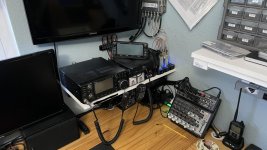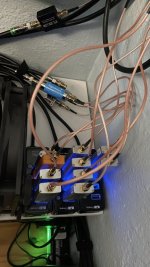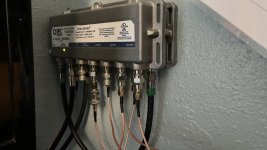Since I seem to have the shack where I want it for now, I figured I'd post a few photos! Photos are at the bottom of this post.
The amateur side of things includes the following:
All physical audio in the shack (i.e. radios/PC) is fed through the mixer to a small 50w amp to feed my desktop speakers. I like to listen to multiple things at once haha.
Regarding the scanner side of things:
Five of the RTL SDR's are for VHF/UHF LMR agencies in the region (CAL FIRE, Sheriff, Police, CHP, EMS, etc...). Those are being used by an RTLSDR-Airband instance that is then fed to a PulseAudio server, then fed into a Liquidsoap server for EQ and balance, then fed to Broadcastify and my own Icecast server. Obviously many of those feeds don't make it to BCFY due to regulations so I listen to them for my own personal use.
Two more of the RTL SDR's are used in an OP25 (boatbod) server which is used to monitor our local P25 system. I monitor multiple TG's and feed the police dispatch to BCFY. The audio is fed to PulseAudio, then to Liquidsoap, then to Icecast just as above.
The last RTL SDR is being used for ACARS data that is fed to airframes.io.
The FlightAware SDR is used for ADSB traffic and is currently being fed to about 6 different servers, as well as my own tar1090 instance.
The Airspy Mini is attached to a spyserver instance so I can share it around my network incase I decide to scan while I'm on my laptop on the couch or the desktop right next to it.
Something else I monitor is local fire dispatch so I feed audio to a TwoToneDetect instance and email/text myself tone outs for stations I care about monitoring due to being near family or friends.
All of the above instances are virtual machines and it has taken me a lot to get things stable and how I want them.
Thanks for looking!



The amateur side of things includes the following:
- ICOM IC-7300 (MARS modded)
- ICOM ID-5100 (MARS modded)
- ICOM ID-51A+ (MARS modded)
- DX Commander Classic
- Arrow Antenna J-Pole
- Pi-Star hotspot for DSTAR on a Pi Zero W
- HamClock running on a Pi Zero W
All physical audio in the shack (i.e. radios/PC) is fed through the mixer to a small 50w amp to feed my desktop speakers. I like to listen to multiple things at once haha.
Regarding the scanner side of things:
- (8) RTL-SDR V3's
- (1) FlightAware ADSB stick
- (1) Airspy Mini
- Old Tram Discone for general purpose scanning
- Custom made Ed Fong knockoff J-Pole
- Laird Low Band CHP antenna
- Larsen 800MHz yagi
- Custom made ground plane ADSB antenna
- (2) Belden PPC 0-gain powered splitters
Five of the RTL SDR's are for VHF/UHF LMR agencies in the region (CAL FIRE, Sheriff, Police, CHP, EMS, etc...). Those are being used by an RTLSDR-Airband instance that is then fed to a PulseAudio server, then fed into a Liquidsoap server for EQ and balance, then fed to Broadcastify and my own Icecast server. Obviously many of those feeds don't make it to BCFY due to regulations so I listen to them for my own personal use.
Two more of the RTL SDR's are used in an OP25 (boatbod) server which is used to monitor our local P25 system. I monitor multiple TG's and feed the police dispatch to BCFY. The audio is fed to PulseAudio, then to Liquidsoap, then to Icecast just as above.
The last RTL SDR is being used for ACARS data that is fed to airframes.io.
The FlightAware SDR is used for ADSB traffic and is currently being fed to about 6 different servers, as well as my own tar1090 instance.
The Airspy Mini is attached to a spyserver instance so I can share it around my network incase I decide to scan while I'm on my laptop on the couch or the desktop right next to it.
Something else I monitor is local fire dispatch so I feed audio to a TwoToneDetect instance and email/text myself tone outs for stations I care about monitoring due to being near family or friends.
All of the above instances are virtual machines and it has taken me a lot to get things stable and how I want them.
Thanks for looking!




